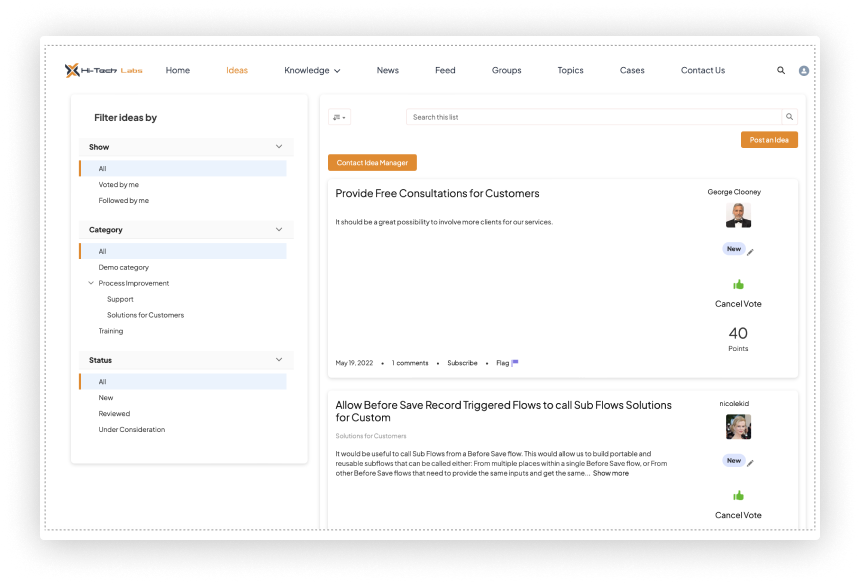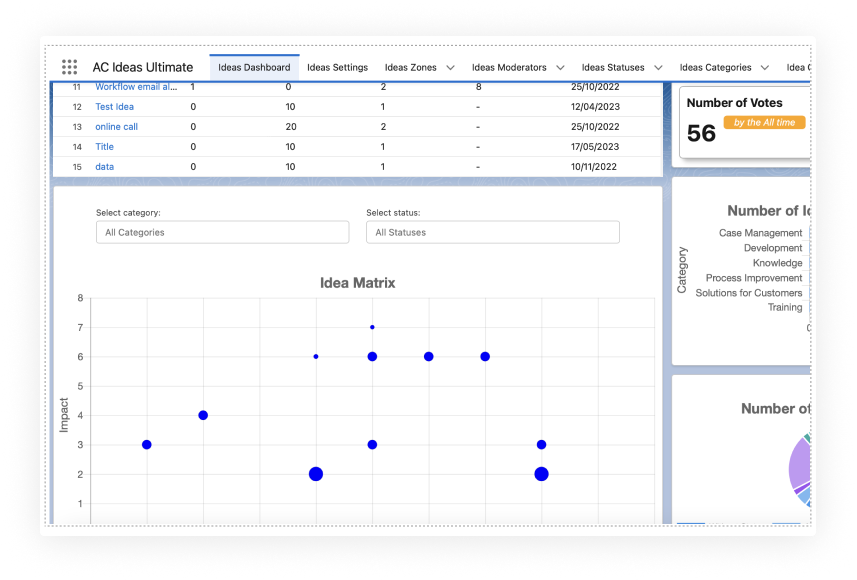Salesforce Idea Management: How To Turn An Idea Into A Product
For all successful and growing companies, innovation is the key to staying competitive. They are constantly seeking new ideas and solutions to address market demands and improve their offerings. However, the process of generating, evaluating, and implementing ideas can be complex and challenging. With the Salesforce platform, organizations can learn how to streamline their idea management processes and how to turn an idea into a product or service.
In this article, we will dive deeper into this process.
Importance of Idea Management in Product Development
Idea management is like the heartbeat of product development – it keeps the innovation flowing! When we gather and assess ideas from different corners, we unlock fresh possibilities, tackle problems head-on, and bring solutions that truly wow our customers. Plus, it’s not just about the end product. It’s about nurturing a culture where creativity thrives, teamwork flourishes, and we’re always one step ahead in the fast-paced world we live in.
Overview of Salesforce as a Tool for Idea Management
Salesforce idea management is a comprehensive solution that covers the entire idea lifecycle within an organization and can provide assistance if you’ve ever wondered how to get an idea manufactured using technologies. It provides a centralized platform where employees, customers, and partners can submit, discuss, and vote on ideas, fostering collaboration and ensuring thorough evaluation and prioritization based on practicability, impact, and alignment with business goals. Leveraging Salesforce’s robust capabilities, organizations can streamline the entire idea management process, from idea generation to product realization, while tapping into the power of data-driven insights and collaboration tools.
What Is Idea Management in Salesforce: Understanding the Power of Innovation

Now, as we had a quick overview of how Salesforce applications can supercharge your ideation process, let’s take a closer look at the key functionalities and advantages the Salesforce platform brings to the table. Plus, we’ll tackle any hurdles you might hit along the way and share some useful tips to help you overcome them.
Salesforce’s Features and Functionalities Relevant to Idea Management
Key features of Salesforce for idea management include idea submission portals, collaborative workspaces, voting mechanisms, and customizable workflows. These features empower organizations to streamline the idea management process, facilitate collaboration, and track the progress of ideas from conception to implementation.
One of the primary advantages of using Salesforce for ideation is its centralized platform for idea collection and collaboration, offering real-time visibility into the status of ideas and seamless integration with other Salesforce products and third-party applications. Additionally, Salesforce’s robust reporting and analytics capabilities enable organizations to gain actionable insights into idea trends, user engagement, and product performance.

At the same time, there may be some inconveniences, such as the need to switch from the Lightning interface to Classic, as the Ideas object is not supported in Salesforce Lightning. Keep reading as we unveil the perfect solution for this issue.
3 Key Steps to Turning Ideas Into Products
Not every idea is a winner when it comes to turning it into a successful product. Before you jump into action, whether it’s whether it involves developing a new feature, hiring more staff, investing in equipment, or any other process specific to your business – it’s essential to take a moment to consider if the idea is worth pursuing. This initial stage serves as a filtering mechanism, eliminating ideas that may not align with your goals or deliver the results you’re looking for.
Despite the possibility of discarding many ideas during this stage, it’s important to recognize the value of the ideation process. Implementing a poorly thought-out idea can prove to be costly, both in terms of resources and time. That’s why it’s essential to follow specific steps to ensure that the ideas you choose to pursue are not only relevant but also cost-effective and impactful.
Let’s delve into these steps together.
1. Finding and collecting ideas
Let’s kick off the idea journey by scouting and gathering ideas from all corners. We’re talking online platforms, brainstorming sessions, or just casual chats where sparks of brilliance can fly. Ideas come in all shapes and sizes, from improving our products to streamlining our processes or even dreaming up something entirely new.
Encourage creativity and open-mindedness in your community to generate a wide range of ideas. The community users are your target audience in this case. Set rewards for posting ideas, commenting, and voting, and award reputation points for each activity.
2. Weighing and ranking ideas
Once we’ve got our hands on some great ideas, it’s time to roll up our sleeves and give them a good look. We’ll weigh them up against criteria like practicality, potential impact, and how well they fit into our big picture. It’s all about figuring out which ideas have the most potential to make waves in the real world.
Consider factors like resources required, market research, potential risks, and estimated return on investment. Use techniques like scoring matrices, cost-benefit analysis, or risk assessments to evaluate and prioritize ideas.
3. Bringing ideas to life
Now comes the exciting part – from idea to product! We’ll put our heads together, fine-tune the details, and do a good testing to make sure everything’s just right. It’s all about crafting something that not only meets but exceeds the expectations of our target market.
Develop a detailed plan for implementing selected ideas into viable products or solutions. Allocate resources, set timelines, and define milestones to track progress throughout the implementation process. Utilize project management tools and methodologies to ensure smooth execution and timely delivery of the final product.

Best Practices for Idea Management in Salesforce
- Establish a systematic process: Define a clear and structured process for idea submission, evaluation, and implementation. This includes setting up standardized criteria for evaluating ideas, market research establishing clear timelines and milestones, and assigning responsibilities to team members.
- Foster a culture of innovation: Encourage idea sharing within your organization and among your target audience. Provide incentives and recognition for employees, community users, or potential customers who contribute valuable ideas. Create opportunities for brainstorming, collaboration, and focus group discussions on the latest business news, aiming to develop solutions relevant to today’s world.
- Promote transparency and communication: Keep stakeholders informed and engaged throughout the idea management process. Provide regular updates on the status of ideas, solicit feedback from relevant stakeholders, and communicate decisions and outcomes transparently.
- Leverage data and analytics: Use Salesforce’s reporting and analytics capabilities to gain insights into idea trends, user engagement, and idea implementation. This allows organizations to identify patterns, track progress, and make data-driven decisions about which ideas to prioritize and invest in.
- Get rid of annoying problems with the help of additional components: Use AC Ideas Ultimate, a fully LEX-native idea management tool built on top of Salesforce, to resolve the previously mentioned issue with switching to the Classic interface every time you use the Ideas object. In addition to allowing you to fully manage all processes connected to ideation in LEX, this app offers many more features that will impress you and definitely simplify the process of how to turn an idea into a product. Let’s see what’s inside!
AC Ideas Ultimate
What you get with AC Ideas Ultimate:
- Zone-based Ideation: Tailor the ideation process to specific products or target audiences by organizing ideas and feedback into distinct zones. Each zone will have its own unique set of ideas, suggestions, and questions, as well as separate settings, categories, and statuses.
- Idea Prioritization: Implement ideas with the best impact by ranking and prioritizing innovation based on factors such as votes, development effort, or monetary value.
- Custom Fields Support: Customize the information you collect by setting up custom fields and fieldsets for creating ideas in Salesforce Lightning and on your site.
- Idea Campaigns: Facilitate the creation of targeted campaigns with dedicated landing pages featuring comprehensive details and descriptions.
- Customizable Reports & Dashboards: Create reports and dashboards to monitor idea performance, track votes, analyze statuses, posts, new feedback, and categories.
- Kanban View Support: View all ideas at a glance with a native Kanban layout, allowing for easy movement between different statuses using drag-and-drop features.
- Jira Integration: Simplify idea tracking by linking Salesforce ideas to Atlassian Jira issues and enabling automated daily syncs. Keep users informed about the status of their ideas, reducing manual effort and increasing engagement in the ideation process.
- Reputation Support: Motivate community members to contribute to the ideation process with reputation support features.
Subscribe to our Newsletter
Q&A
How do I turn my idea into a prototype?
To turn your product idea into a prototype, start by documenting your idea clearly and comprehensively. Then, conduct market research to understand the market demand and competition. Next, create a basic prototype using available tools or software. Iterate on your prototype based on feedback, testing, and refinement. Finally, consider seeking assistance from professionals or leveraging resources like prototyping workshops or online platforms to secure your intellectual property and enhance your prototype further.
Can you sell just an idea to a company?
Yes, it is possible to sell just an invention idea to a company, but it can be challenging. Companies often value tangible assets such as prototypes, patents, or market-ready products more than mere ideas. However, if your idea is innovative, viable, and addresses a specific need or problem, you may be able to license or sell it to a company. From the legal and business standpoint it’s essential to protect your idea with a non-disclosure agreement (NDA) and find a skilled patent professional for an initial patent search, and legal advice to navigate negotiations and ensure fair compensation.
How much is a good idea worth?
The value of a good idea varies depending on various factors such as its uniqueness, target market, market demand, potential impact, and the industry it pertains to. Some ideas may have the potential to revolutionize entire industries and generate substantial revenue, while others may have limited applicability or require significant investment to develop. Ultimately, the worth of a good idea is subjective and can range from a few hundred dollars to millions or even billions, depending on its execution and market reception.




